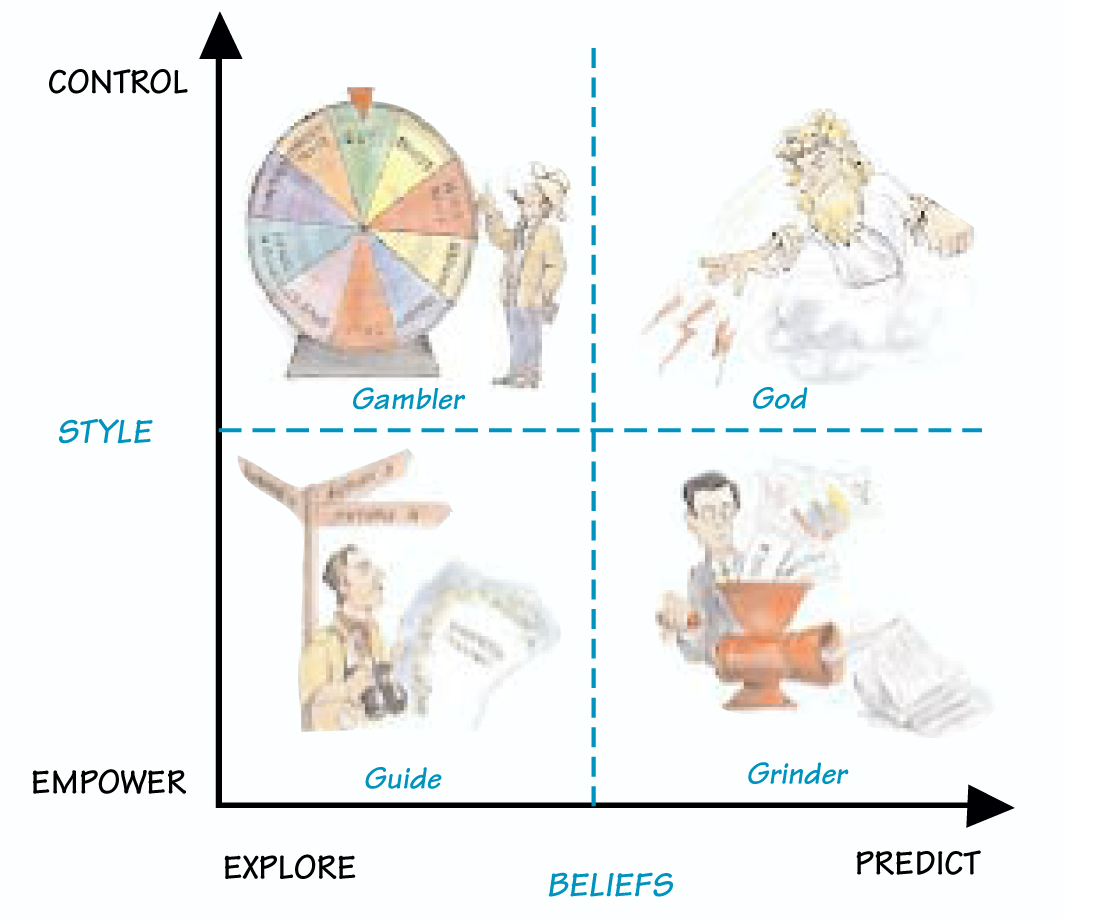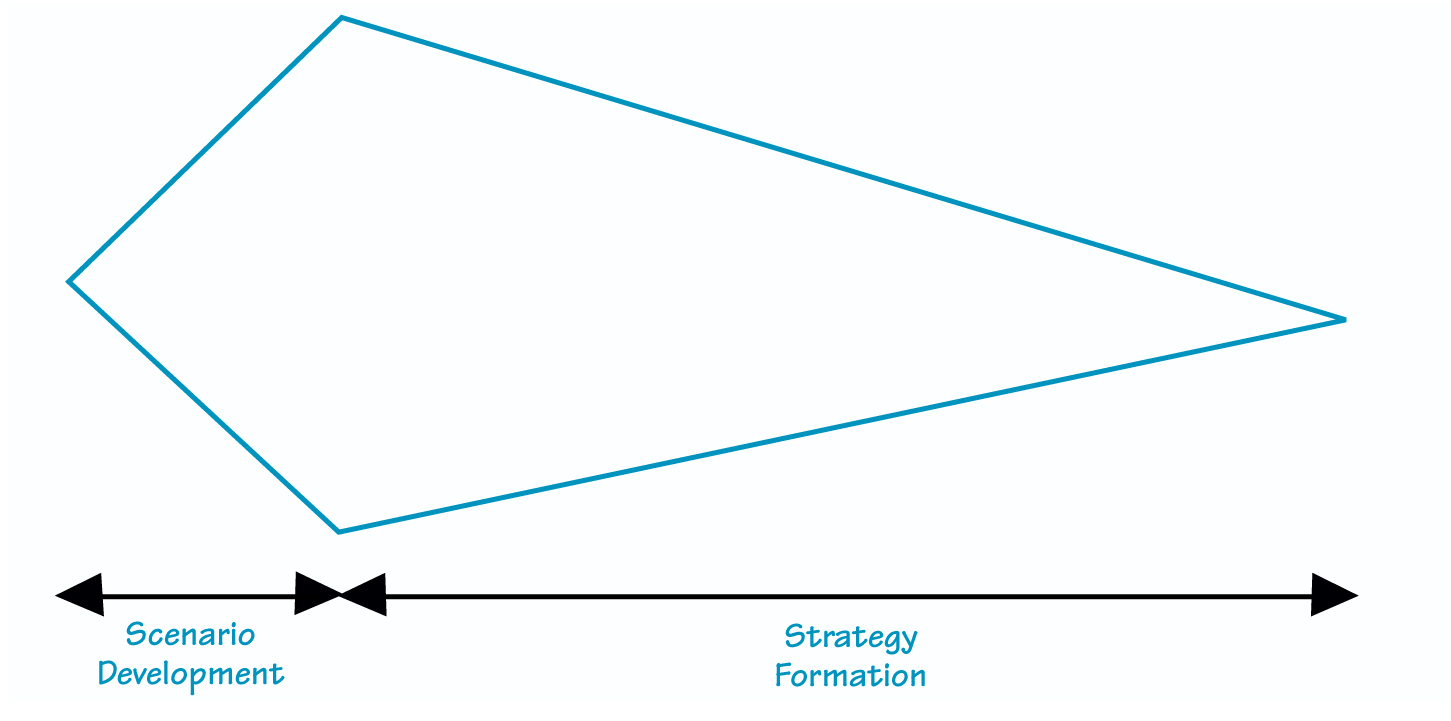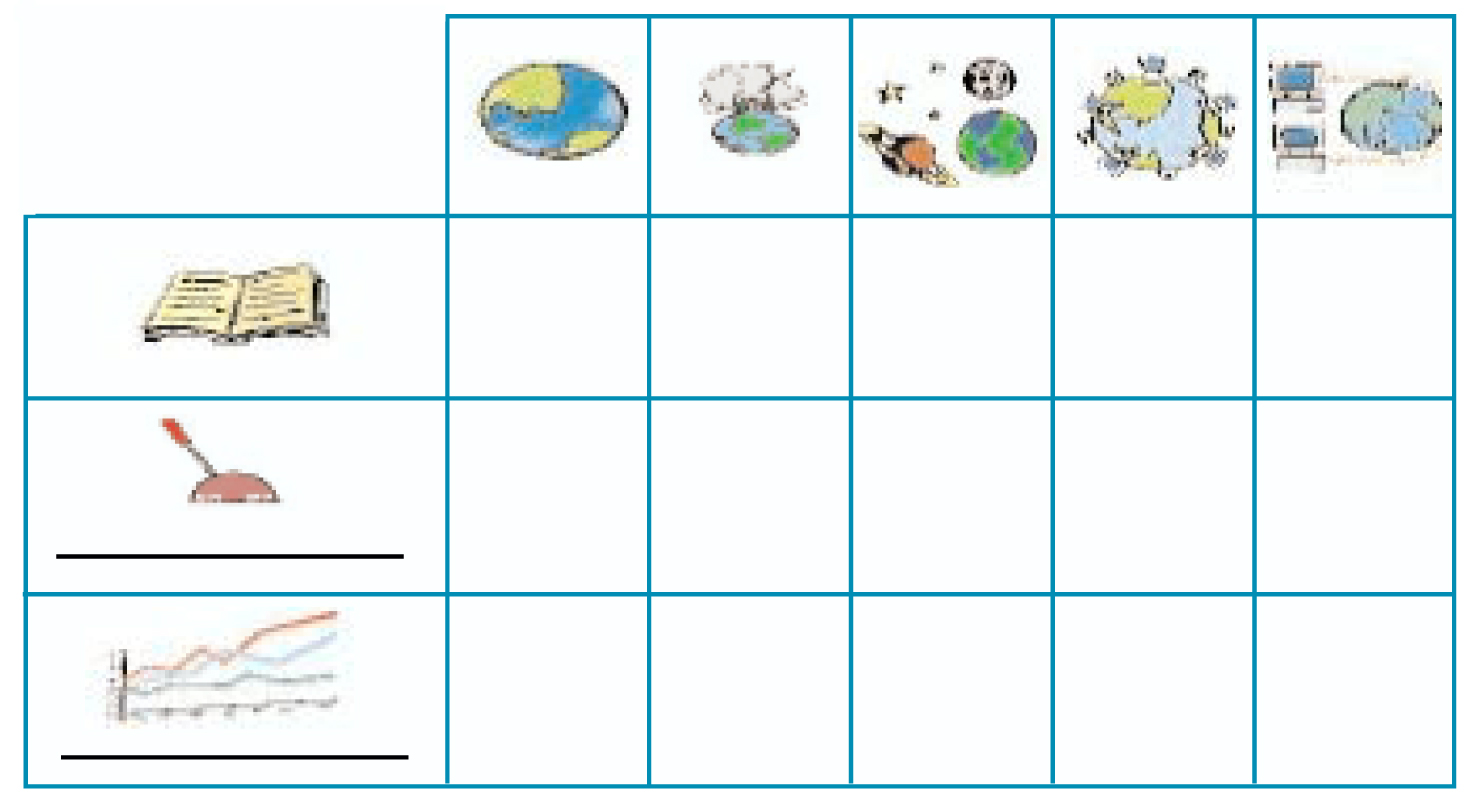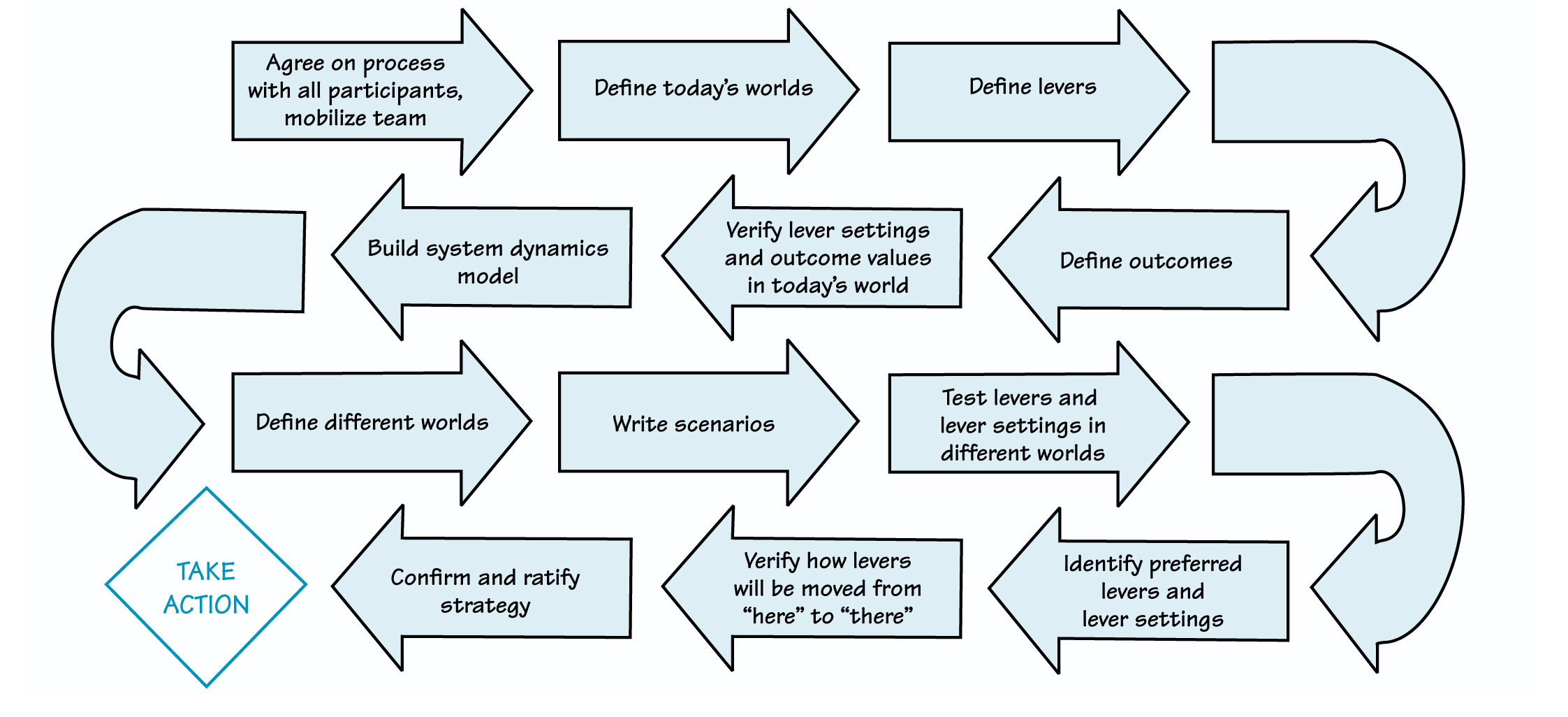There are many definitions of strategy. The one that means most to me is:
A shared commitment to act toward a compelling goal.
Why do I like it?
- First, it emphasizes that strategy is about action – not about analyzing, forecasting, writing papers, filling out forms, compiling spreadsheets, but about action.
- Second, it speaks of a shared commitment – the kind of commitment that management needs so that they continue to act as a team, even when things get tough.
- Third, it recognizes the importance of a compelling goal – the objective, that, when realized, brings vision into reality.
I recognize that the statement makes no declaration about what the goal should be or about what actions should be taken, but I ask that you ride with that gap for the moment — all will be revealed in due course. I also recognize that are many ways of building a shared commitment to act and of defining a good strategy. Scenario planning, which I will focus on, is just one of them.
Gods, Gamblers, Grinders, and Guides
TEAM TIP
When looking to use scenarios as part of a strategic planning process, remember that the most detailed and accurate scenarios in the world are meaningless unless your organization has a robust process for making decisions and moving to action. When outlining a timetable, be sure to leave as much time for making decisions and implementing strategies as you do for developing the alternative worlds.
All organizations have their own dominant beliefs, and top managers have their own styles. Some people believe, for example, that it is possible to predict the future (if not in general, then at least as far as their own organizations are concerned); others prefer to believe that the future is uncertain and that the journey into the future is one of exploration. As regards style, some leaders exercise very strong control, while others seek to empower those in their organizations (see “Four Leadership Styles”).
Strong, controlling leaders who believe they can predict the future are much like gods: Not only do they know what they want, they know best, too. You don’t have to read Homer to learn that any mortal who incites the wrath of an angry god soon has an uncomfortable time. Such leaders need no tools and techniques to formulate a strategy: They know. From time to time, they might actually be right.
Strong, controlling leaders who are less certain of their powers of prediction often behave like gamblers: They place a bet that the future will evolve in a certain way and, if it does, fine; if it doesn’t, well, let’s throw the dice again and see what happens a second time. Gamblers, too, need few tools and techniques, but they might like some financial analyses to give them a feel for the odds.
Empowerers who believe they can predict the future are convinced that, somewhere out there, the “right” strategic answer exists, if only they can find it. These are the grinders, managers who are forever grinding away on more analyses, more research, more numbers. These people love tools and techniques, with their five forces, their value chains, their PERTS, and their SWOTS.
In many cases, the most successful leaders may be those empowerers who choose to serve as guides: They seek to carefully steer their organizations through the uncertainties that the future will inevitably bring. How can they steer the safest course? Well, to do so, they need a map. The problem is that no such map can be found, for maps exist in space, not in time.
FOUR LEADERSHIP STYLES

It is in this last arena that scenarios can help, for scenarios are stories describing how the future might evolve. Scenarios therefore do a similar job in time to that done by maps in space. But because the future might evolve in many ways, there are many possible scenarios, each of which represents one possible view of what might happen over the next five, 10, or 20 years. Importantly, the emphasis within each scenario is not on the internal aspects of the business, but rather on the external context in which the business might operate; robust scenarios depict the future in terms of politics, economics, sociology, demography, technology, and industrial structures.
By imagining what such a future might be, you can test whether or not a particular strategy for your own business will be beneficial, should that future indeed come to pass. And by explicitly recognizing that there might be several different futures, any one of which might happen, you can test your strategy against each and see if some strategies are more robust than others. In essence, scenario planning is a form of simulation: It is the business manager’s equivalent of the jet pilot’s flight simulator. The scenarios project you and your organization into the future, and provide a realistic, rich context in which you can examine whether or not particular strategies – the development of new products, the entry into new markets, or whatever – are likely to be successful.
Scenarios also serve to heighten your understanding of risk, so that when you put your strategy into action, you will be much more aware of how changes in the external environment are likely to impact your business. Then if you notice that the world is in fact evolving in a direction for which your strategy is less appropriate, you will be able to change course easily and quickly, far more so than your competitors, who may not have noticed what is going on, or, if they have, may continue for some time in a state of denial.
But how does scenario-based strategic planning – to give it its full name – actually work?
Scenario-Based Strategic Planning
Scenario-based strategic planning comprises two principal activities:
- First, the development of a small number of scenarios – say, up to five – each of which describes a different view of how a future world might look.
- Second, the agreement on a strategy – a set of actions that the organization is committed to take.
As indicated by “Scenario Development and Strategy Formation,” the process of scenario development is divergent and strives to embrace as broad as possible a view of how the future might evolve, in order to encompass the future’s inevitable uncertainties. This is done through a series of group workshops, supported by research, and the gathering of expert opinions. The purpose of the scenarios is to provide a series of backdrops against which different strategies can be assessed. Questions such as “Should we enter the [whatever] market?”, “What are the risks of making [whatever] investment?” and the like are tested against each of the scenarios. Participants assume that, yes, they do enter that market, and that, yes, they do make that investment, and then imagine that they and their organization are projected into each scenario 10 years into the future. They can then assess, using “projected hindsight,” whether or not those decisions were “good” or “bad.” By exploring various decisions against each scenario in this way, team members can then determine that set of decisions that they collectively feel most comfortable taking now and therefore converge upon an agreed strategy.
The following pages describe the process in more detail. First, we need to introduce and define three terms that have a special role in scenario planning: worlds, levers, and outcomes.
Worlds. A world is a comprehensive description of the context in which a business operates. Worlds are therefore described in terms of (often long!) lists of adjectives and adjectival phrases, describing all aspects of the world of interest, including the political, social, economic and regulatory structures, nature of market competition, technology, and all the rest.
SCENARIO DEVELOPMENT AND STRATEGY FORMATION

The process of scenario development is divergent and strives to embrace as broad as possible a view of how the future might evolve, in order to encompass the future’s inevitable uncertainties. The purpose of the scenarios is to provide a series of backdrops against which different strategies can be assessed. By exploring various decisions against each scenario in this way, team members can then determine that set of decisions that they collectively feel most comfortable taking now and therefore converge upon an agreed strategy.
The most familiar world is today’s world, and an important part of the scenario planning process is to come to a shared view of just what it is. Different people see different things, and some lively workshops can be run focused on describing today’s world. Ultimately, any description of today’s world must pass the Martian Test: If the description were e-mailed to a group of Martians approaching Earth, on stepping out of their saucer, they must be able to recognize where they have landed.
If today’s world is defined in terms of a long list of descriptive phrases, then, by definition, a different world must have a different list. A major milestone in scenario planning is to generate a small number of different worlds – three to five is usually sufficient – that have self-consistent descriptions. These worlds should be significantly different from one another, and from today’s world.
Some of the different worlds might appear favorable, others harsh; some may appear to be relatively likely, other less so; some might be desirable, others positively repulsive. At the moment, though, such issues aren’t important; all that matters is that any different world must be believed to be, in principle, possible.
Levers and Outcomes. Levers represent the actions and decisions that managers can take. For example, managers can determine product range, target markets, staffing levels, skills, investments in infrastructure, level of R&D, location of manufacturing sites, amount spent on advertising, and so on. At any time, each lever has a setting – the numeric amount associated with that lever.
Outcomes represent the commercial results of the organization: levels of sales and profit, reputation, share price, market share, staff morale, and so on. At any time, each outcome has a numeric value.
Fundamentally, the job of strategic management is to determine the levers and assign their settings, so as to generate desirable outcomes. As every manager soon learns, however, levers are not directly connected to outcomes; there simply is no lever to allow managers to directly control profit, market share, or share price. Rather, the levers that managers can actually pull are only indirectly, and sometimes rather loosely, coupled to the outcomes, and managers act in the belief – or hope – that by cutting costs here and increasing staff there, shareholder value will be increased. To make matters worse, time delays occur before any change in a lever setting begins to take effect.
This process is, as we all know too well, very complex. A powerful tool in taming this complexity is system dynamics modeling. This kind of simulation goes far beyond the typical spreadsheet and can handle loosely coupled variables, time lags, and feedback loops. (For a more complete definition of system dynamics, go to http://www.systemdynamics.org.)
The Rules of Innovation
Many people feel that inventing new worlds is difficult, fearing not only that they lack the expert knowledge, but also – and far worse – that they just don’t have the imagination. In fact, inventing new worlds is easy and a lot of fun, provided, of course, that you do it in the easy, fun way – and that is to borrow from the techniques of innovation.
Briefly, two of the key rules that make innovation deliberate, systematic, and safe are:
- Rule No. 1: Don’t try to leap directly into the unknown – start from something or somewhere you know well.
- Rule No. 2: New ideas are best generated not by waiting for lightning to strike, but by challenging assumptions and asking, “How might this be different?”
A simple but nonetheless startling example of these rules in action is the familiar nine dots puzzle (see “Nine Dots Puzzle”). There are two questions:
- How can you join all nine dots with four straight lines, without taking your pencil off the page?
- And if that is too easy, how many different ways can you find of joining all the dots with just one line?
NINE DOTS PUZZLE

Most people tackle the first question by picking up a pen and drawing various alternatives; they usually don’t even know where to start with the second question. But then most people don’t know the two rules of innovation. Picking up a pen, drawing, and trying to solve the puzzle by trial and error breaks the first rule – you’re leaping into the dark. The first rule says “Let’s understand all we can about the nine dots.” There are nine, they are in a square array, they are an inch or so apart, and they are about a quarter-inch square. The second rule says, “Challenge the assumptions.” Is the shape the dots form a square? What would happen if the dots weren’t an inch apart? They might be a mile apart or close together. But if they were close, I could wipe a felt-tip pen across all nine at once. So, if they’re an inch apart, I need a thick pen – maybe a paint roller. Ah yes, that’s it, a paint roller. And the puzzle is instantly solved.
Inventing New Worlds
The easiest way of inventing new worlds is therefore to apply the two key rules of innovation defined above. In the context of scenario planning, if we follow Rule No. 1, our starting point is something we all know well indeed, namely, today’s world. In fact, we take the time to define today’s world not only to build a genuine, deeply shared view of where we are, but also as a springboard to innovation.
One observation about today’s world might be that “the current industrial structure is consolidating.” Rule No. 2 requires us to challenge assumptions and ask, “How might this be different?” How might the industrial structure be different? Well, perhaps it will concentrate even further into a global monopoly; perhaps it will fragment as a result of government intervention; perhaps new entrants will come in on the back of a new technology.
Applying Rule No. 2 thus results in many alternative possibilities. As a group begins to list these potential futures, people start associating characteristics together, so that a small number of self-consistent worlds emerge, each with its appropriate set of descriptions. Created by a process of deliberate challenge and deliberate and systematic innovation, these descriptions will be very different from today’s world. When you are in the middle of the process, it can appear to be something of a muddle, with hundreds of post-its all over the walls. But rest assured that it works: The human mind is quite adept at seeing patterns. Just as the solution to the nine dots puzzle emerged, seemingly out of nowhere, so the process of challenge, coupled with the interactions of a group and the human ability to see patterns, will create a compelling series of new worlds.
“Scenario Planning Summary” forms the heart of a scenario planning exercise. Each column represents a different world, the first being today’s world. The often extensive descriptions of each world are incorporated in the first row. The levers are named in the title box of the second row, and the corresponding lever settings are identified in the appropriate column. Similarly, the outcomes are named in the title box of the third row, and the outcome values, for the defined lever settings in each world, are assessed and entered into each column.
The question then becomes, What are the lever settings and what new levers might be required to give favorable outcomes in as many of the worlds as possible? Once the most favorable set of levers and lever settings have been determined, then your strategy is that set of managerial actions required to move the levers from their current settings to the desired ones.
Testing the Levers
By now, you will have:
- Defined today’s world.
- Defined up to five alternative worlds.
- Defined the levers and the outcomes.
- Seen how the lever settings in today’s world generate today’s outcome values.
It is at this point that the scenarios themselves are written, each scenario being a vivid story describing how each of the alternative new worlds evolved, in its own particular way, from today’s world. Well-written scenarios capture your imagination and are powerful vehicles for communication and training. Immersing yourself in the scenarios builds “a memory of the future,” so that as time passes and the future becomes reality, you recognize what you see. But the scenarios themselves are not the end of the exercise: The purpose of the scenarios, and the alternative worlds they describe, is to form a context in which your business might operate in the future.
SCENARIO PLANNING SUMMARY

To test out this method:
- Imagine that the levers and their settings are the same as in today’s world. What will the outcome values be in the different worlds? Are they favorable or unfavorable?
- If the outcome values in any alternative world are unfavorable, what would the lever settings have be to give rise to favorable outcomes? Do you need to invoke any new levers?
This process is best carried out through group discussion; it can also be supported by modeling and specific, well-focused analysis. The objective is to examine how robust different lever settings are to future uncertainty. Suppose, for example, you decide that the current lever settings give favorable outcome values in just one of the alternative future worlds. That analysis implies that, if you leave the lever settings as they are and that particular future does indeed come to pass, your business is likely to be successful. But if the future were to evolve toward any of the other worlds, things might not be so rosy.
Turning Scenarios into Strategy
As a result of the exploration of the lever settings in the various worlds, you will discover one of a number of things, for example, that:
- The current levers, and their settings, are indeed robust under future worlds, or
- The current levers, and their settings, are not robust under future worlds, or
- Some different lever settings are robust under many of the future worlds, including today’s world; or there are no lever settings that work well under many worlds, but several clusters of settings that work well in some worlds but not others; or there are no generally safe lever settings – each world has its own.
These insights are guides to strategy. How so? Let’s go back to our definition of strategy: a shared commitment to act toward a compelling goal.
A shared commitment to take what specific actions, toward which particular goal? Well:
- The goal must be defined in relation to one or more of the worlds, and
- The actions must be to move existing levers to new settings or to deploy new levers.
The process of strategy development is therefore that of deciding which levers need to be placed at what settings. And the strategy itself is the set of actions you decide to take to move the levers from their current settings to their new ones.
Scenario-based strategic planning has the objective of providing a framework to enable managers to make strategic decisions (see “The Scenario-Based Strategic Planning Process”). These decisions can relate only to levers and their settings; managers, quite literally, can do little else. As we all know, the problem with resetting the levers is that some of them are difficult to reset; some, once reset, cannot be reversed to their original settings; many require a long time to reset; and, once settings have been reset, it may be a long time before the results are actually achieved—time during which the world is fast evolving, often in such a way as to make the new settings no longer fit for their originally conceived purpose.
THE SCENARIO-BASED STRATEGIC PLANNING PROCESS

Scenario-based strategic planning has the objective of providing a framework to enable managers to make strategic decisions. As such, it comprises a number of activities, beginning with defining today’s world and the range of actions that managers can take to creating scenarios of different possible worlds to testing levers in different settings and, finally, identifying effective actions.
But the levers must be reset from time to time. Doing nothing, and so betting that the world will stay still, is often a worse bet than taking a gamble on one particular future. The process is exciting, challenging, stimulating, exhausting, amazing – and, most importantly, it works.
NEXT STEPS
- Identify the focal issue or decision. What will decision-makers in your organization be thinking hard about in the near future?
- Identify key forces in the local environment — facts about customers, suppliers, competitors, etc.
- List the driving forces. You can start with a checklist of social, economic, political, environmental, and technological forces. This is the most research-intensive step. Search for major trends.
- Rank key factors and driving forces by importance and uncertainty. Identify two or three that are both most important and most uncertain.
- Select scenario logics. The results of this exercise are the axes along which the eventual scenarios will differ. Avoid a proliferation of scenarios; choose only a few “scenario drivers.”
- Flesh out the scenarios. The logics give the basic framework of the scenarios; now return to the key factors and trends listed in Steps 2 and 3. Each key factor and trend should be given some attention in each scenario.
- Explore implications. Return to the focal issue or decision in Step 1. How does it look in each scenario? What vulnerabilities have been revealed? Is the strategy robust across all scenarios? How could it be adapted to make it more robust?
- Select leading indicators and signposts. As time unfolds, you will want to know which scenario is closest to the course of history as it actually unfolds. The indicators and signposts will help you decide.
Additional Considerations
- Beware of ending up with three scenarios. People are often tempted to identify one of them as the “middle” or “most likely” and ignore the rest.
- Avoid assigning probabilities to scenarios. However, it may make sense to make two reasonably likely scenarios and compare them to two “wild card” scenarios.
- Pay a great deal of attention to naming your scenarios. Successful names telegraph the scenario logics.
- Pick your scenario team based on these considerations: 1) support and participation from the highest levels is essential; 2) a broad range of functions and divisions should be represented; 3) look for imaginative people with open minds who can work well together as a team.
- You can tell you have good scenarios when they are both plausible and surprising; when they have the power to break old stereotypes; and when the makers assume ownership of them and put them to work.
Dennis Sherwood is the author of nine books, including Seeing the Forest for the Trees: A Manager’s Guide to Applying Systems Thinking, Smart Things to Know About Innovation, and Unlock Your Mind. For 12 years, he was a consulting partner with Coopers & Lybrand and was subsequently an executive director at Goldman Sachs in London, a partner in Bossard Consultants, and vice president of SRI Consulting. He is currently with the Silver Bullet Machine Manufacturing Company. Dennis was educated at the Universities of Cambridge, Yale, and California, and is a Sloan Fellow, with distinction, of the London Business School. He is a well-known speaker at conferences, has written many journal articles, and has appeared on BBC Radio 4’s programs In Business, Shoptalk, and Nice Work.
